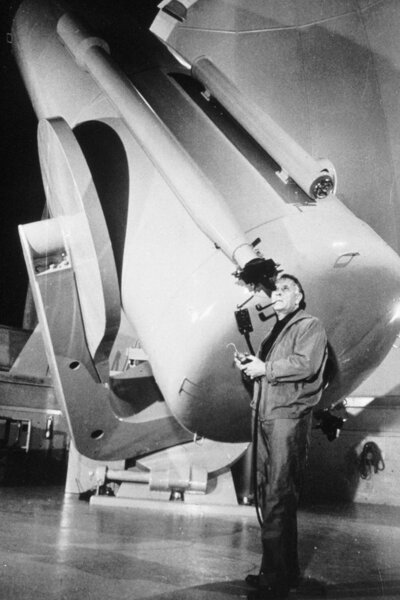How a janitor at the Mount Wilson Observatory measured the size of the universe
Loading...
At One-Minute Astronomer, we always have a soft spot for the “underdog astronomer”. Someone who overcomes circumstance to make great astronomical discoveries with skill and curiosity and raw enthusiasm.
We’ve already looked at the remarkable stories of E. E. Barnard and Henrietta Leavitt.
Today, a snapshot of Milton Humason, a former mule driver and janitor who rose to work with Edwin Hubble to establish the distance scale of the universe and become one of the best-known American astronomers of the 20th century.
IN PICTURES: Images from the Hubble telescope
Milton Humason was born in Dodge Center, Minnesota in 1891. When he was 14 years old, his parents sent him to a summer camp on Mount Wilson, near Los Angeles. The mountain’s forests and soaring views of southern California stole the heart of the prairie boy. He convinced his parents to let him take a year off school to stay on the mountain and find work.
He never returned to school.
Instead, Humason took up work as a mule driver, hauling lumber up a trail from the Sierra Madre to Mount Wilson to build the new astronomical observatory… an enormous project organized by the astronomy pioneer George Ellery Hale.
In 1911, Humason’s heart was stolen once more: he became engaged to Helen Dowd, the daughter of the chief engineer of the observatory on Mount Wilson. They married shortly after. He left to work as a foreman on a ranch in nearby LaVerne. But he missed the mountain. In 1917, Humason saw his chance to return and to impress his father-in-law: he took a position as observatory janitor. This was a big step up from mule driver and ranch hand.
Soon after, the new observatory posted a position for “night assistant”, which is essentially a helper for astronomers who need to operate the telescope and observatory dome. Humason took up the role. His patience and skill and diligence brought him to the attention of Hale himself. In 1919, in the face of stern protests, Hale appointed Humason… a high-school dropout… to the scientific staff of the observatory. Humason remained in the role until 1954.
Humason worked with Hubble, and later Hubble’s protege, Allan Sandage, to study the spectral redshift of hundreds of galaxies to determine how fast they were receding… their so-called “radial velocity”. Hubble (correctly) believed the radial velocity of a galaxy was related to its distance, a relationship now known as “Hubble’s Law”.
But these far-away galaxies had low surface brightness, and were notoriously hard to measure. So Humason developed techniques to optimize the photographic exposures and plate measurements. He determined the radial velocities of 620 galaxies, and helped set the distance scale and age of the universe. Much of Hubble’s success was attributed to Humason’s painstaking measurements.
For his achievements, Humason was awarded an honorary doctorate from the University of Lund in Sweden. He retired in 1957, and died in Mendocino, California, in 1972 at the age of 80.
In 2005, Humason’s life was the subject of the musical “The Expanding Sky” by the writer Stan Peal.
Brian Ventrudo blogs at One-Minute Astronomer.
View all of the One-Minute Astronomer posts on the Monitor.
IN PICTURES: Images from the Hubble telescope
Related
Happy birthday to the Hubble Telescope
Hubble Telescope turns 20! Here's 10 space targets you can spot without the Hubble.





